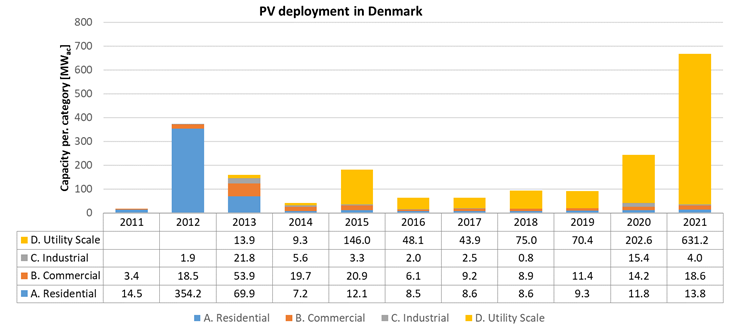Denmark deployer around 667.6MW of new PV capacity in 2021, according to new figures provided by the Danish PV association Solcelleforening.
“Around 94% of this capacity comes from utility scale solar plants built without subsidies,” Flemming Vejby Kristensen, from the Danish trade body, told pv magazine. “And the remaining share is mainly represented by commercial and industrial PV systems.”
Unsubsidized large scale PV projects, according to Vejby Kristensen, are constantly gaining market share in a market dominated by the wind power renewable energy source, as more and more big corporations are willing to have clean electricity from the solar source, regardless of the economic profitability that big PV facilities can ensure for their owners. “Through power purchase agreements, these corporations may have agreed to buy power at a slightly higher price that than of grid electricity at the time of the signing of the deals, before the current energy price crises,” Vejby Kristensen further explained. “But they also ensured a stable price for several years while increasing their renewable energy share, which in Denmark is a crucial factor for a company's image and success.”
According to provisional numbers provided by Solcelleforening, large scale solar accounted for 631.2MW of the solar power installed last year while industrial and commercial installations reached 22.6MW and residential arrays reached a total 13.8MW. For comparison, in 2020 Denmark deployed a total of 244MW, of which 202.6MW were for utility scale projects.
“In 2022 and 2023, we may see even a bigger growth,” Vejby Kristensen added. “And grid-parity PV plants will still have the lion's share, despite rising modules prices.”
Popular content
According to him, in fact, the LCOE of PV plants is not rising as much as panel and inverter prices and the fundamentals of building more solar parks without subsidies remain strong. “This was also shown by the most recent auctions held by the Danish authorities, which showed the price of solar has now become competitive with that of onshore wind,” he further explained. “And the wind industry is particularly strong here.”
As for the failed technology-neutral auction held by the Danish authorities last year, for which no bid was submitted, Vejby Kristensen stated that this failure was due to the possibility that the current government will introduce a grid fee for renewable energy power plants, starting from 2023. “This measure is currently being discussed and it is still unclear if it will be implemented,” he emphasized. “However, this possibility has created uncertainty among potential investors and I would say it was the main reason for the auction's failure. On the other hand, it also showed that renewables auctions are no longer necessary, as grid-parity projects keep proliferating in Denmark.”
Referring to the rooftop segment, Vejby Kristensen explained that current net metering rules are ensuring some good development levels, especially for commercial and industrial projects. “The current electricity prices have significantly reduced payback time for rooftop PV arrays and more growth should materialize this and next year,” he also stated, noting that current incentives for heat pumps may also become a driver for more volumes in the residential segment. “The Danish government is pushing for more heating powered by renewables.”
The scheme is open to companies specializing in district heating and offers rebates covering up to 15% of the total investment made to buy and install a heat pump, with developers being eligible for a maximum of DKK5 million (€672,000) for each project.
This content is protected by copyright and may not be reused. If you want to cooperate with us and would like to reuse some of our content, please contact: editors@pv-magazine.com.



1 comment
By submitting this form you agree to pv magazine using your data for the purposes of publishing your comment.
Your personal data will only be disclosed or otherwise transmitted to third parties for the purposes of spam filtering or if this is necessary for technical maintenance of the website. Any other transfer to third parties will not take place unless this is justified on the basis of applicable data protection regulations or if pv magazine is legally obliged to do so.
You may revoke this consent at any time with effect for the future, in which case your personal data will be deleted immediately. Otherwise, your data will be deleted if pv magazine has processed your request or the purpose of data storage is fulfilled.
Further information on data privacy can be found in our Data Protection Policy.